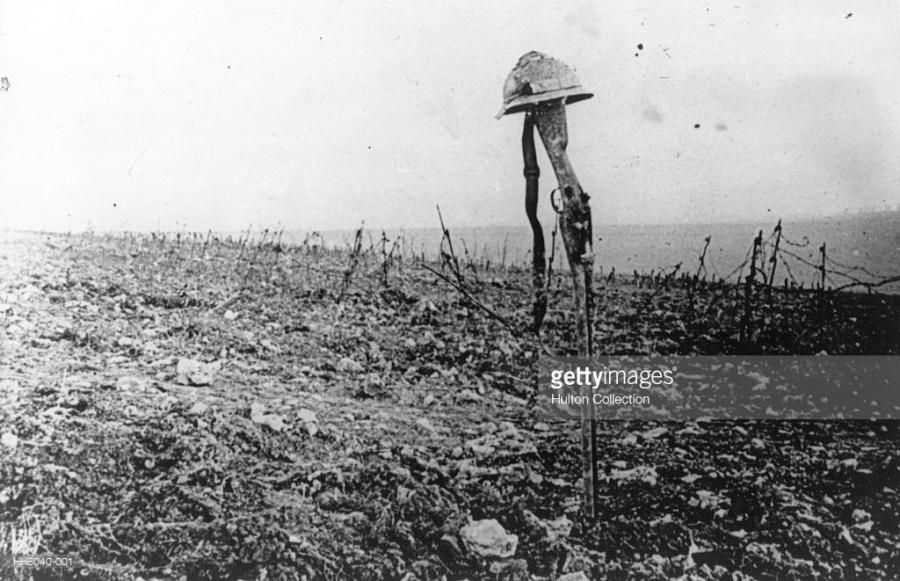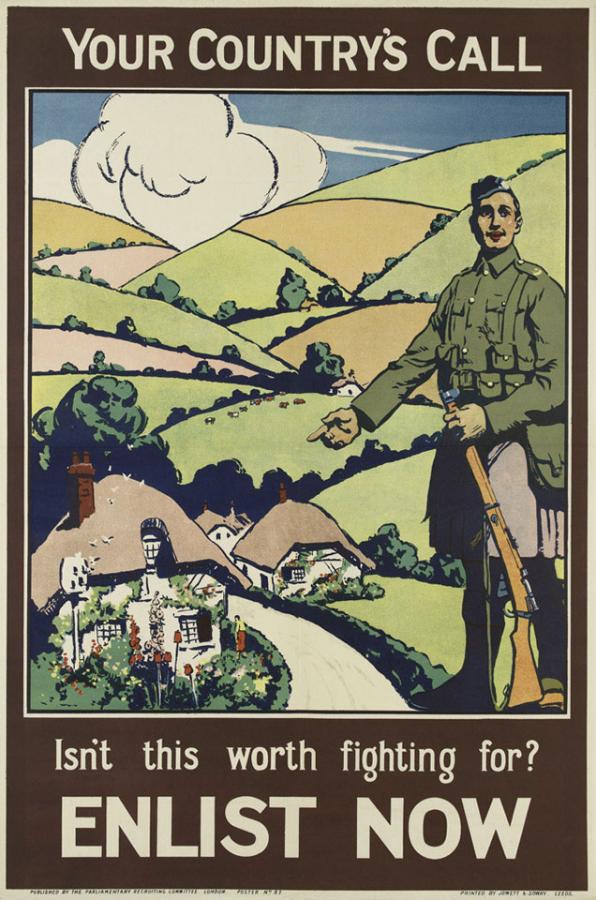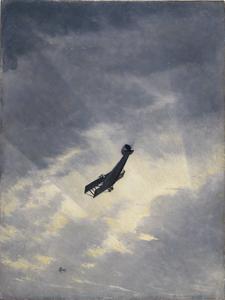On this day: 11 November 1916
On 11 November 1918 the guns fell silent.
However, on 11 November 1916, one hundred years to this day, the end was nowhere in sight.
Some 38,000 Australians were yet to lose their lives, almost twice the number already lost since the war had started in 1914.
The Australians had already given their all on the scrub-laced hills of Gallipoli, in the waterlogged trenches of Fromelles, and the cratered hellscape of Pozieres. No one could deny that the Australians had earned their keep.
Before the end they would have to face many more hardships, tests of character, strength and resilience.
The end, however, was two years away, and to those writing in their diaries and letters on 11 November 1916, the end was but a dream.
Thomas James ‘Rusty’ Richards, serving with the 1st Australian Field Ambulance, wrote:
"...to write, as I most desire to do it, is necessary to forget much of our sordid surrounding and work. Tonight I brought down some rather severe cases in my wagon, and the groans and shouts of pain haunt me and I believe will haunt me regardless of my desire to draw a screen over my experiences...”
Diary of Thomas James Richards, 9 November - 12 December 1916. [RCDIG0001491]

Benjamin Bennett Leane, serving with the 48th Battalion, wrote:.
"At last we left the main road and headed for Delville Wood. There we rested a while. Doesn’t that sound delightful? We rested and ate our lunch in Delville Wood. At once you picture a beautiful scene – a grassy slope with perhaps a trickling stream running by; tall trees thick with foliage now beautiful with their autumn tints. The birds singing; a timid deer peering out from behind some nearby thicket; a rabbit scuttling across the open. Yes, I don’t think. Twelve months ago Delville Wood was possibly like that. Today is bears no more likeness to its original self than does a hideous, grinning skeleton to the beautiful face and form that once covered it."
Delville Wood, France. September 1916. British Army soldiers digging a communication trench through the area. [AWM H15929]
"Today it looks like all the other woods, all the other villages through which this terrible offensive has been pushed. The trees are mere stumps, torn asunder by our and the enemy shell fire, stripped absolutely bare of every leaf and twig and branch. The ground is bare of anything in the nature of grass, and is lined with broken trenches and seamed with shell holes like the face of a pock marked man. And everywhere is strewn the disorder and wreckage that follow in the trail of war – broken wagons, overturned guns, abandoned rifles and equipment, bodies lying half-buried in the mud, a rifle struck bayonet-end in the ground and a steel hat on top to mark the spot where some British soldier has been hastily buried; unexploded shells, bombs, anything and everything. And all the shell holes half-filled with water curiously tinted red. You wonder for just a fraction of a second why – and then you remember. For here the fight raged intensely."
Photostat copy of diaries of Benjamin Bennett Leane, 1915-1916. [RCDIG0001007]
Leane would be killed in action on 10 April 1917 at Bullecourt.
Apcar Leslie De Vine, serving with the 4th Battalion, wrote:
"Very good day. Sun shining for about 5 hours. Ground much better and drying quickly, but a keen wind blowing. An aeroplane fight took place over our camp during the afternoon, the Taube falling in flames just inside our lines, the boys cheering our aviator when he returned.”
Diary of Apcar Leslie De Vine, 25 May - 31 December 1916. [RCDIG0000332]
A 'Mock Burial' taking place on board the transport ship HMAT Ulysses, the burial was of fish which was served as a meal but regarded as inedible. One man in white is acting the role of padre and the 'body' is draped in an Australian Flag. c.1915 [AWM A00890]
William Emanuel Baker, having recently left Australia aboard the troopship HMAT Ulysses, wrote:
“A very impressive scene occurred tonight just before the storm. We had cold meat for tea and it smelt pretty high, so the lads complained about it, so the doctor came down and examined it and informed us that it was alright being one of the peculiarities of frozen mutton, and we would notice it more as the meat grew older. At any rate there was a funeral procession after tea, coming along from the miner’s quarters. There were two in front carrying the dish of meat with between them with their heads turned away from it, and holding their noses, they were followed by a number of men, all holding their noses, and the whole walking slowly. They marched down to the end and then to the side and held a burial service “Dust thou art and dust thou shalt return” and then the remains were confined to the deep with great reverence and holding of noses, It was very amusing and characteristic of the miners.”
Typescript copy of diary of William Emanuel Baker, 1916. [RCDIG0001163]
Baker would be killed in action on 21 March 1918 near Kemmel.
Australian ambulance men at Bernafay assisting their comrades, who are suffering from trench feet, to a transport which is to convey them to hospital. December 1916. [AWM E00081]
Arthur G. Thomas, serving with the 6th Battalion, wrote:
“Cold cheerless day, no sun, our poor feet, quite a lot have trench feet, a bad complaint. We are to be relieved tonight. Two wounded, only three feet from me.”
Transcript of diaries of Arthur Thomas, 1916-1918. [RCDIG0001097]
Thomas would be killed in action on 8 June 1918 near Strazeele.
Appleford was betrothed to Lieutenant Harry Lowry Moffitt, who was killed at Fromelles on 19 July 1916 serving with the 53rd Battalion. He can be seen here on the left. [AWM DAX0633]
Alice Ross-King (née Appleford), serving at the 2nd Australian Casualty Clearing Station and still suffering the recent loss of her fiancé Harry, wrote:
“I am suffering very much. Millicent’s Bob is down here for a few days before he goes up the line & the sight of her happiness brings the pain of my loss closer again. My God! How can I bear it? My ward is full of very heavy cases.”
Diary of Alice Ross-King, 1916. [RCDIG0001097]

"Your Country's Call". A kilted Scottish infantryman stands before rolling English hills and picturesque thatched cottages. 1915. [NAM. 1977-06-81-22]
Norman Griffiths Ellsworth, having recently been transferred to the 21st Field Artillery Brigade and sent back to England for training, wrote:
"The autumn is now here, and it is quite impossible for me to adequately describe the beauty of the local country, as every tree has a different colour, - and such colour too, and to see the fast running streams, with their falls here and there, and the old waterwheels, and the old fashioned country farm houses with their thatched roofs, which look so very snug and cozy, and the more that I see of the English country, the more delightful it appears to me, and the more infatuated I get with it, and do not mind how long I stay in it, and I often and often wish that you were all here to see for yourselves, and then you would see how very difficult it is for one to describe, and more especially me.”
Letters from Norman Griffiths Ellsworth to his Mother, 1916. [RCDIG0000231]
Ellsworth would be killed in action on 31 July 1917 near Zillebeke.
A bronze plaque made to be mounted in honour of the soldiers of the 4th Australian Division who fought in France and Belgium from 1916 to 1918. [AWM H03229]
Robert Edmund Antill, recovering in England after having been wounded with the 14th Battalion at Pozieres in August, wrote:
“I have heard today from very good authority that the Australians have been simply cut to pieces again down on the Somme and the 4th Division I was in has been practically wiped out of existence and as you can guess they are trying to keep it dark for a while. They are sending men back from here as fast as they can to reinforce the others but I tell you they don’t get me till after Xmas and then I will go back willingly.”
Letters from Robert Edmund Antill to his Parents, 1916. [RCDIG0000321]
Antill would be killed in action on 5 July 1917 near Ploegsteert.
A typical illustration of the difficulties encountered in the Ypres Sector in Belgium, in transporting supplies to the forward areas. 19 October 1917. [AWM E00963]
Ernest William Baker, serving with the 20th Battalion, wrote:
“I am O.K. but have very little time to myself owing to the bad state of the country. When I tell you it takes 15 hours to get rations up to the line and then only on pack horses you will be able to form some idea of the difficulties; I am thankful to say that up to the present we haven’t failed the boys and you can bet your bottom dollar that we won’t unless we all get wiped out and that’s not likely to happen.”
Letters from Ernest William Baker to his Family, 1914-1918. [RCDIG0000172]
Baker would be killed in action on 14 May 1918 in France.
Portrait of Brigadier General John Monash CB, VD. October 1915. [AWM A01241]
Back in England, a wargames exercise was developed for the 11th Infantry Brigade of John Monash's 3rd Division:
“Enemy (Red) have invaded England from the North and present situation is a passive defensive on both sides. Enemy line running DEVIZES-URCHFONT-THE BUSTARD-DURNFORD-ALDERBURY.”
Personal Files Book 14, 6 October - 30 November 1916. [RCDIG0000616]
A ward in the 2nd Australian Casualty Clearing Station near Steenvoorde. 30 November 1917. [AWM E04623]
Mary Anne 'Bessie' Pocock, serving at the 2nd Australian Casualty Clearing Station, wrote:
“Pte. Long died 4am. Poor boy, bladder case as well as leg wound.”
Diary of Mary Anne 'Bessie' Pocock, December 1915 - January 1917. [RCDIG0001395]
A soldier wading through the mud in Gird Trench, near Gueudecourt, in December 1916. [AWM E00577]
Alexander Jackson Cunningham, serving with the 2nd Field Company Engineers, wrote:
“Hear that Div. is being relieved. Weather is too awful for “stunting” as the mud makes it impossible for men to run and besides they are all absolutely done. Some of them in the front line had no hot food for days and were sleeping in water and standing in mud in places up to their wastes. The condition of the trenches is indescribable. They are trying hard to “push” but if this weather continues it’s impossible – not only the trenches up there but the roads etc. for getting up rations are beyond words. We are waiting now for orders.”
Diary of Alexander Jackson Cunningham, 1916-1917. [RCDIG0000919]
An Australian officer of the Imperial Camel Corps, on a camel in the desert. 1918. [AWM B01479]
No 1 Battalion, Imperial Camel Corps leaving El Kharga. c.1917 [AWM H00774]
Henry 'Harry' Langtip, serving with the Imperial Camel Corps, wrote:
“Same old thing. Don’t know when we are going to shift, been bad with diarrhoea but getting alright again.”
Diary of Henry 'Harry' Langtip, 1916. [RCDIG0000898]
A scene on the battlefield near Courcelette. The two British soldiers are carrying German helmets. Note the bodies along the side of the road. 1916. [AWM H07183]
Edward Michael McNamee, serving with the 9th Battalion, wrote:
“Got relieved by “C” Coy last night, got out of the trenches a bit better owing to us having cleared them out during the day. We only had a few shells thrown at us on the way out and considered ourselves lucky. We passed a number of dead laying unburied about the fields...”
Diary of Edward Michael McNamee, 1915-1917. [RCDIG0000998]














